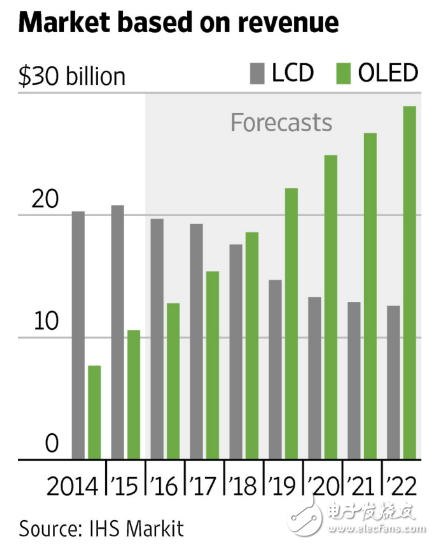Apple's suppliers say they are being asked to increase the production of OLED displays and submit higher-resolution display prototypes than Samsung. Apple hopes to differentiate its mobile phone products by using lighter and thinner OLED displays.
Apple is currently struggling to curb the decline in smartphone sales. In addition, Apple will usher in the 10th anniversary of the iPhone's release next year, and how to launch a hot-selling product will also put pressure on it. According to sources, the iPhone with OLED display will be one of several models released by the company next year. However, the price of the new iPhone may be higher because the production cost of the OLED display is also higher.
Apple declined to comment on the report.
Apple's old rivals such as Samsung Electronics, Xiaomi, and Google (microblogging) have switched to OLED displays from current LCD displays because they are thinner and lighter and can support curved surfaces. The OLED display does not require backlighting components to illuminate the screen. Analysts expect OLED displays to cost up to $50 more.
Getting Apple's long-term supply contract will bring billions of dollars in revenue to display makers in a distressed situation. Market research firm IHS Markit predicts that smartphone OLED displays will generate revenues that will exceed LCD displays by 2018, reaching $18.6 billion. Last year, the market for smartphone LCD displays reached $20.8 billion, while the OLED market was $10.6 billion.

Samsung Electronics Co., Ltd., a subsidiary of Samsung Electronics, currently dominates the smartphone OLED display market and is one of the few manufacturers that can mass-produce the parts on a large scale. Although Samsung Electronics and Apple compete in the global smartphone market, the former has long provided the latter with other components such as memory chips.
Apple has spent years diversifying its display suppliers. For this reason, Apple has relied on LG Display, Japan Display and Sharp to supply its ReTIna display, which uses LCD technology.
However, in terms of OLED technology investment, LG Display, Japan Display and Sharp are behind Samsung. Samsung Light has spent nearly $10 billion this year to expand its production and R&D of OLED displays. At the same time, LG Display plans to invest nearly $3 billion by 2018 to expand its smartphone OLED display production.
Both Japan Display and Sharp are facing financial difficulties and it is difficult to increase production capacity. Japan Display is negotiating with funds supported by the Japanese government to obtain a new round of bailouts. Sharp, which is in deep debt crisis, sold it to Foxconn, a Taiwanese foundry company, for 388.8 billion yen ($3.5 billion) earlier this year. After the acquisition of Sharp, Foxconn's management also questioned OLED technology because of excessive manufacturing costs.
Sources pointed out that Apple's initial supply of OLED displays may rely on Samsung. However, Apple also hopes that LG Display, Japan Display and Sharp will increase production capacity and prepare for supply in 2018.
The source also pointed out that Sharp may need to spend more than 5 billion US dollars to meet Apple's demand for OLED panels.
Sharp President Dai Zhengwu said last month: "We will make samples of OLED displays, but I don't see their potential to develop into a huge market."
Investment in OLED technology is at risk, and whether this technology will become mainstream is still full of uncertainty. In terms of picture quality, OLED technology does not have obvious advantages. Analysts say that the technology used by display makers to make flexible screens has yet to be improved, and it may take years for consumers to use a foldable phone.
IHS Markit analyst Jerry Kang pointed out that several companies already have the technology to produce OLED folding screens and curlable screens, but he is cautious about whether these technologies can be commercialized.
Jerry Kang said that components inside the panel, such as touch sensors and protective glass, would limit the flexibility of such displays.
To hedge the risk, Japan Display has marketed its next-generation LCD panel Full AcTIve to Chinese handset manufacturers. According to Japan Display, the new technology will use film instead of glass as the base material, which is comparable to shoulder OLED in terms of flexibility, picture quality and service life.
Japan Display CEO Mitsuru Homma said earlier this month: "We will invest in the research and development of OLED mass production lines, because this is the demand of our customers, but the basis of our business is still LCD panels. â€
Weatherproof/Waterproof Type F Outlets
"Waterproof Type F Outlets Black,Waterproof Type F Outlets,Waterproof Outlet Plug,Waterproof Exterior Outlet "
Yang Guang Auli Electronic Appliances Co., Ltd. , https://www.ygpowerstrips.com